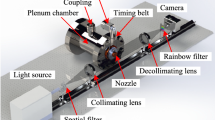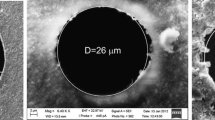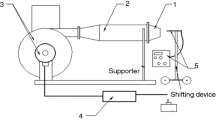Abstract
The present study focuses on the collapse length of compressible rectangular microjets whose Mach numbers range between 0.3 and 1.5. The microjets are created from a convergent rectangular nozzle whose height is 500 μm at its exit. The techniques of planar laser-induced fluorescence (PLIF) and molecular tagging velocimetry (MTV) are used to visualize the microjets. The PLIF images reveal that each microjet spreads abruptly at a certain location. It is confirmed from the instantaneous MTV images that this location corresponds to the location where the jet starts to collapse. The jet collapse length, which is defined as a distance between the nozzle exit and jet collapse location, is estimated from the PLIF image. The plot of the collapse length versus the jet Reynolds number reveals that the collapse length is inversely proportional to the Reynolds number for subsonic and ideally expanded microjets. On the other hand, the collapse length for underexpanded microjets is almost uniform when the jet Reynolds number is higher than a certain value (~ 103) although the length is inversely proportional to the Reynolds number for the lower Reynolds numbers. To clarify the reason why such peculiarities appear in the underexpanded microjets, the numerical flow simulations are carried out. The results reveal that the collapse length remains constant as long as a jet screech occurs. Consequently, the collapse length of the screeching jet is related to the feedback length in the jet. The critical Reynolds numbers at which laminar-turbulent transition occurs are estimated from the collapse lengths of the microjets without screeching and plotted against the convective Mach number. It is found that the critical Reynolds number increases with the convective Mach number.
Graphic abstract







reproduced from Handa et al. (2017)














Similar content being viewed by others
References
Alskilar MB, Krothapalli A, Lourenco LM (2003) Structure of a rectangular screeching jet: a stereoscopic particle image velocimetry study. J Fluid Mech 489:121–154
Aniskin V, Mironov S, Maslov A (2013) Investigation of the structure of supersonic nitrogen microjets. Microfluid Nanofluid 14:605–614
Aniskin V, Mironov S, Maslov A, Tsyryulnikov IS (2015) Supersonic axisymmetric microjets: structure and laminar-turbulent transition. Microfluid Nanofluid 19:621–634
Bruccoleri AR, Leiter R, Drela M, Lozano P (2012) Experimental effects of nozzle geometry on flow efficiency at low Reynolds numbers. J Propuls Power 28:96–105
Dimotakis PE (1991) Turbulent free shear layer mixing and combustion. In: High-speed flight propulsion systems, pp 265–340, Published by AIAA.
Doms M, Müller J (2007) Design, fabrication, and characterization of a micro vapor-jet vacuum pump. J Fluids Eng 129:1339–1345
Gau C, Shen CH, Wang ZB (2009) Peculiar phenomenon of micro free-jet flow. Phys Fluids 21:092001
Giordano J, Parisse JD, Perrier P (2008) Numerical study of an original device to generate compressible flow in microchannel. Phys Fluids 20:096101
Giordano J, Perrier P, Meister L, Brouillette M (2018) Shock wave attenuation in a micro-channel. Shock Waves 28:1251–1262
Han B, Matsuda Y, Egami Y, Handa T (2018) Investigation on choking behavior of gas flow in microducts. Microfluidic Nanofluidic 22:122
Handa T, Masuda M, Kashitani M, Yamaguchi Y (2011) Measurement of number densities in supersonic flows using a method based on laser-induced acetone fluorescence. Exp Fluids 50:1685–1694
Handa T, Mii K, Sakurai T, Imamura K, Mizuta S, Ando Y (2014) Study on supersonic rectangular microjets using molecular tagging velocimetry. Exp Fluids 55:1725
Handa T, Matsuda Y, Egami Y (2016) Phenomena peculiar to underexpanded flows in supersonic micronozzle. Microfluid Nanofluid 20:166
Handa T, Kambara H, Harada M (2017) Visualization of supersonic microjets using LIF and MTV techniques. IOP Conf Ser Mater Sci Eng 249:012016
Handa T, Matsuda Y, Egami Y (2019) Peculiarities of low-Reynolds-number supersonic flows in long microchannel. Microfluid Nanofluid 23:88
Hong C, Yoshida Y, Matsushita S, Ueno I, Asako Y (2015) Supersonic micro-jet of straight micro-tube exit. J Therm Sci Tech 10:JTST0026
Huang C, Gregory JW, Sallivan JP (2007) Flow visualization and pressure measurement in micronozzles. J Vis 10:281–288
Kai Y, Garen W, Teubner U (2018) Experimental investigation on microshock waves and contact surfaces. Phys Rev Lett 120:064501
Krothapalli A, Hsia Y, Baganoff D, Karamcheti K (1986) The role of screech tones in mixing of an underexpanded rectangular jet. J Sound Vib 106:119–143
Lempert WR, Boehem M, Jiang N, Gimelshein S, Levin D (2003) Comparison of molecular tagging velocimetry data and direct simulation of Monte Carlo simulations in supersonic micro jet flows. Exp Fluids 34:403–411
Mirshekari G, Brouillette M, Giordano J, Hébert C, Parisse J-D, Perrier P (2013) Shock waves in microchannels. J Fluid Mech 724:259–283
Nagai H, Naraoka R, Sawada K, Asai K (2008) Pressure-sensitive paint measurement of pressure distribution in a supersonic micronozzle. AIAA J 46:215–222
Namer I, Ötügen MV (1988) Velocity measurements in a plane turbulent air jet at moderate Reynolds number. Exp Fluids 6:387–399
Namura M, Toriyama T (2013) Experimental study on aerodynamics of microelectromechanical systems based on single-crystal-silicon microscale supersonic nozzle. J Fluids Eng 135:081101
Papamoschou D, Roshko A (1988) The compressible turbulent shear layer: an experimental study. J Fluid Mech 197:453–477
Phalnikar KA, Kumar R, Alvi FS (2008) Experiments on free and impinging supersonic microjets. Exp Fluids 44:819–830
Roe PL (1981) Approximate Riemann solvers, parameter vectors, and difference schemes. J Comput Phys 43:357–372
Satoh D, Tanaka S, Yoshida K, Esashi M (2005) Micro-ejector to supply fuel-air mixture to a micro-combustor. Sens Actuators A 119:528–536
Savitzky A, Golay MJE (1964) Smoothing and differentiation of data by simplified least squares procedures. Anal Chem 36:1627–1639
Schlichting H, Gersten K (2000) Boundary-layer theory, 9th edn. Springer, Berlin
Scroggs SD, Settles GS (1996) An experimental study of microjets. Exp Fluids 21:401–409
Takahashi Y, Okajima J, Iga Y, Komiya A, Fu W-S, Maruyama S (2013) Study of supersonic micro-channel for cooling electronic devices. In: Proceedings of ASME 11th Int. Conf. Nanochannel Microchannel Minichannel, ICNMM2013–73134.
Tam CKW (1988) The shock-cell structures and screech tone frequencies of rectangular and non-axisymmetric supersonic jets. J Sound Vib 121:135–147
Valentich G, Upandhyay P, Kumar R (2016) Mixing characteristics of a moderate aspect ratio screeching supersonic rectangular jet. Exp Fluids 57:71
Walker S, Thomas FO (1997) Experiments characterizing nonlinear shear layer dynamics in supersonic rectangular jet undergoing screech. Phys Fluids 9:2562–2579
Wilcox DC (1992) Dilatation-dissipation corrections for advanced turbulence models. AIAA J 30:2639–2646
Yamamoto S, Daiguji H (1993) Higher-order-accurate upwind schemes for solving the compressible Euler and Navier-Stokes equations. Comput Fluids 22:259–270
Zaman KBMQ (1996) Axis switching and spreading of an asymmetric jet: the role of coherent structure dynamics. J Fluid Mech 316:1–27
Author information
Authors and Affiliations
Corresponding author
Additional information
Publisher's Note
Springer Nature remains neutral with regard to jurisdictional claims in published maps and institutional affiliations.
Rights and permissions
About this article
Cite this article
Handa, T. Study on the collapse length of compressible rectangular microjets. Exp Fluids 61, 196 (2020). https://doi.org/10.1007/s00348-020-03030-5
Received:
Revised:
Accepted:
Published:
DOI: https://doi.org/10.1007/s00348-020-03030-5




